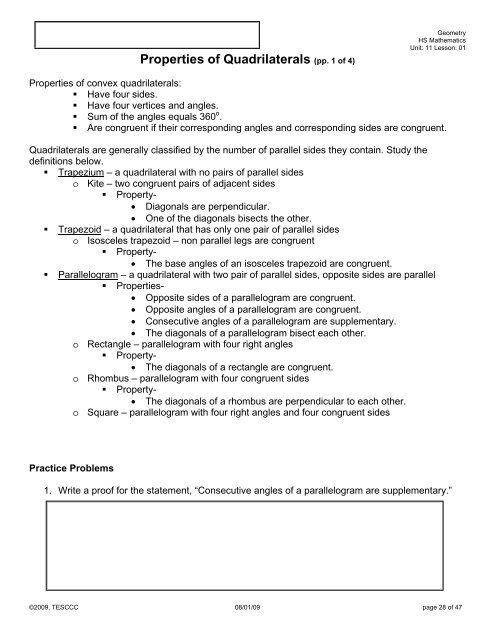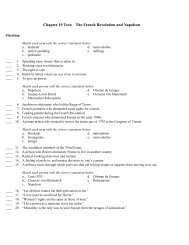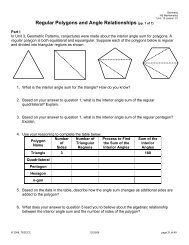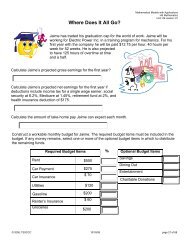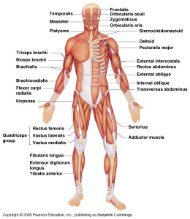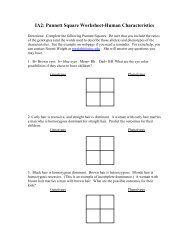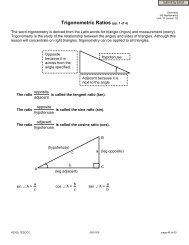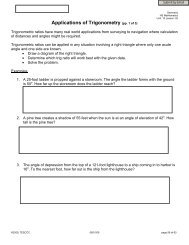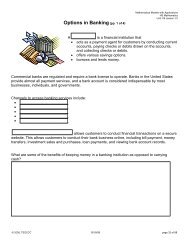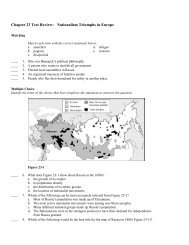Properties of Quadrilaterals (pp. 1 of 4)
Properties of Quadrilaterals (pp. 1 of 4)
Properties of Quadrilaterals (pp. 1 of 4)
Create successful ePaper yourself
Turn your PDF publications into a flip-book with our unique Google optimized e-Paper software.
<strong>Properties</strong> <strong>of</strong> <strong>Quadrilaterals</strong> (<strong>pp</strong>. 1 <strong>of</strong> 4)<br />
Geometry<br />
HS Mathematics<br />
Unit: 11 Lesson: 01<br />
<strong>Properties</strong> <strong>of</strong> convex quadrilaterals:<br />
Have four sides.<br />
Have four vertices and angles.<br />
Sum <strong>of</strong> the angles equals 360 o .<br />
Are congruent if their corresponding angles and corresponding sides are congruent.<br />
<strong>Quadrilaterals</strong> are generally classified by the number <strong>of</strong> parallel sides they contain. Study the<br />
definitions below.<br />
Trapezium – a quadrilateral with no pairs <strong>of</strong> parallel sides<br />
o Kite – two congruent pairs <strong>of</strong> adjacent sides<br />
Property-<br />
Diagonals are perpendicular.<br />
One <strong>of</strong> the diagonals bisects the other.<br />
Trapezoid – a quadrilateral that has only one pair <strong>of</strong> parallel sides<br />
o Isosceles trapezoid – non parallel legs are congruent<br />
Property-<br />
The base angles <strong>of</strong> an isosceles trapezoid are congruent.<br />
Parallelogram – a quadrilateral with two pair <strong>of</strong> parallel sides, o<strong>pp</strong>osite sides are parallel<br />
<strong>Properties</strong>-<br />
O<strong>pp</strong>osite sides <strong>of</strong> a parallelogram are congruent.<br />
O<strong>pp</strong>osite angles <strong>of</strong> a parallelogram are congruent.<br />
Consecutive angles <strong>of</strong> a parallelogram are su<strong>pp</strong>lementary.<br />
The diagonals <strong>of</strong> a parallelogram bisect each other.<br />
o Rectangle – parallelogram with four right angles<br />
Property-<br />
The diagonals <strong>of</strong> a rectangle are congruent.<br />
o Rhombus – parallelogram with four congruent sides<br />
Property-<br />
The diagonals <strong>of</strong> a rhombus are perpendicular to each other.<br />
o Square – parallelogram with four right angles and four congruent sides<br />
Practice Problems<br />
1. Write a pro<strong>of</strong> for the statement, “Consecutive angles <strong>of</strong> a parallelogram are su<strong>pp</strong>lementary.”<br />
©2009, TESCCC 08/01/09 page 28 <strong>of</strong> 47
<strong>Properties</strong> <strong>of</strong> <strong>Quadrilaterals</strong> (<strong>pp</strong>. 2 <strong>of</strong> 4)<br />
2. Write a pro<strong>of</strong> for the statement, “The diagonals <strong>of</strong> a rhombus are perpendicular.”<br />
Geometry<br />
HS Mathematics<br />
Unit: 11 Lesson: 01<br />
3. In the parallelogram below, PG = 2x – 7, MR = x + 5, and MG = 2x – 5. Find the value <strong>of</strong> x,<br />
PG, MR, and MG.<br />
M<br />
R H<br />
B<br />
M O<br />
P G<br />
R<br />
4. Use the information in the rectangle below to find the value <strong>of</strong> x, the value <strong>of</strong> y, TE, RC, RP,<br />
EP, TP, and CP.<br />
R x<br />
E<br />
y<br />
T 4<br />
C<br />
P<br />
3<br />
©2009, TESCCC 08/01/09 page 29 <strong>of</strong> 47
<strong>Properties</strong> <strong>of</strong> <strong>Quadrilaterals</strong> (<strong>pp</strong>. 3 <strong>of</strong> 4)<br />
Geometry<br />
HS Mathematics<br />
Unit: 11 Lesson: 01<br />
5. Su<strong>pp</strong>ose a carpenter is framing a rectangular room and wants to verify that the 4-sided room is<br />
“square” (meaning each corner forms a right angle). What might the carpenter do to verify that<br />
each corner forms a right angle without measuring the angles?<br />
6. Su<strong>pp</strong>ose a room is constructed in the shape <strong>of</strong> a rhombus so that one diagonal is 6 ft. long and<br />
the other is 8 ft. long. Find the perimeter <strong>of</strong> the rhombus.<br />
7. Use the information in the trapezoid below to find the value <strong>of</strong> x, the value <strong>of</strong> y, mT, mR,<br />
and mP.<br />
T R<br />
(12x+60)º (5y)º<br />
(4x+40)º 80º<br />
P A<br />
8. Use the information in the trapezoid below to find HK, IJ, mKHI, mKJI, and mHIJ.<br />
H I<br />
6 3<br />
60º<br />
K J<br />
©2009, TESCCC 08/01/09 page 30 <strong>of</strong> 47
<strong>Properties</strong> <strong>of</strong> <strong>Quadrilaterals</strong> (<strong>pp</strong>. 4 <strong>of</strong> 4)<br />
Geometry<br />
HS Mathematics<br />
Unit: 11 Lesson: 01<br />
9. Su<strong>pp</strong>ose the length <strong>of</strong> EI is 10 ft. Use the information in the kite below to find the perimeter <strong>of</strong><br />
the kite.<br />
K<br />
E<br />
10. Given the formula for the area <strong>of</strong> a triangle, Atriangle = ½(base)(height), use the properties <strong>of</strong><br />
quadrilaterals to derive the formula for the area <strong>of</strong> a rhombus in terms <strong>of</strong> its diagonals.<br />
d2<br />
45º<br />
30º<br />
T<br />
45º<br />
60º<br />
d1<br />
I<br />
©2009, TESCCC 08/01/09 page 31 <strong>of</strong> 47


